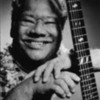Thank you for this beeeautiful post dearestest Inda!
Rest in peace Dear Ray Kane (player of the Hawaiian harp



)
quote:
Originally posted by dear Inda:
Mr.Kane is survived by his wife, Elodia, a traditional singer who often performed with him. He leaves seven children, many grandchildren and two siblings.
From:
http://www.folklife.si.edu/hawaii/slackkey.htm Ray Kane playing slack-key guitar at home
Ray Kane playing slack-key guitar at home
in Nanakuli, O'ahuPhoto by Lynn Martin, 1992Slack-key guitar playing in Hawai'iPua Sardinia (Gardenia Flower)," composed and performed by Raymond Kane
 First phrase,
First phrase, 116 kB .AU
Complete stanza, 429 kB .AU
Spanish and Mexican cowboys who worked on
the numerous cattle ranches throughout Hawai'i introduced the guitar to the islands. They brought a playing style that
influenced the development of
k� h� 'alu (slack-key guitar).
They say that the art of the slack-key guitar is to Hawai'i as the flamenco guitar is to Spain and the Delta blues guitar is to Mississippi. Each style represents the music indigenous to the particular areas as expressed through a single instrument--the six string guitar. Each style is a unique contribution to the world of music. Slack-key guitar music is a uniquely Hawaiian
synthesis of traditional Hawaiian vocal styles with elements of Western music. In slack-key guitar, the
six strings are loosened or "slackened" to produce an open chord when strummed. This remarkable and creative style is traditionally learned by imitation, without tablature or scores.
Many
tunings have names, such as "taro patch," "
wahine," and "
mauna loa." Like
Hawaiian songs, some tunings are said to be passed down from one person to another. In older times,
some tunings were regarded as secret, much like a recipe for a
favorite food or the text for a special
mele chant. It is not unusual for a slack-key guitarist to turn away from an audience to tune, so that no one can copy his private tuning.
Slack-key tunings give rise to specific melodic and harmonic patterns, sometime called "runs" or "vamps." These patterns form the building blocks for composition and improvisation. In the Hawaiian language, the slack-key vamp and the transitional phase of a hula are both called
k�holo, another tie between pre-European Hawaiian music and slack-key guitar style.
The melodic and harmonic contour of slack-key resembles
ancient Hawaiian chant, mele. The slack-key guitarist plucks out the melody on the treble strings, while plucking out a harmonizing rhythmic line on the bass strings. The guitarist may also intersperse strummed chords within the plucked melodic line.
Slack-key tunings also allow the guitarist to insert ornaments such as hammer-ons, hammer-offs, and harmonics. Called ho'op�p�, or "bells" or "chimes," the guitarist produces harmonics by touching the string above the fretboard at specific vibration nodes without making contact with the frets. Slack-key ornaments resemble vocal ornaments in Hawaiian
chanting.







